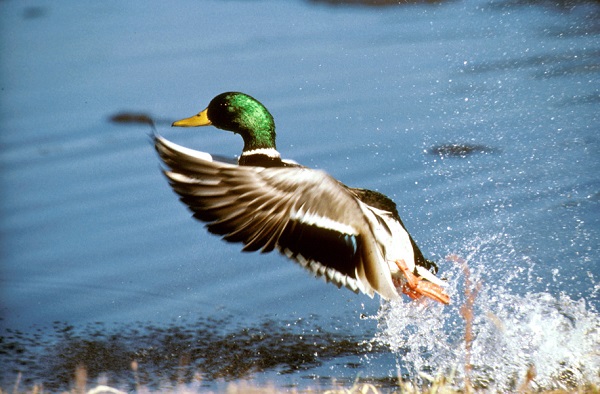Fish Report for 2-2-2017
Why Not a Split Season for California Waterfowl?

by Carrie Wilson
2-2-2017
Website
Question: Global warming and climate change seem to have seriously affected waterfowl migration patterns. Last year we saw the effects exacerbated as birds delayed migrations from summer nesting grounds until late into the year. So, why do we ignore this change in California and persist in starting our waterfowl season so early in the year? My native state of Texas pushed its waterfowl season opener back into early November. Baja Mexico, just a stone’s throw south of us, has a waterfowl season that runs later and doesn’t close until the end of February. And further south in the Mexican states of Sonora and Sinaloa, the seasons run as late as March.
How about considering a split season? One option our extremely elongated state could employ would be to open waterfowl season in the northern part of the state a month before the southern part of the state. Another option could be to have an early season for a couple of weeks, separated by a two to three week break, and then a late season that runs to the end of February. Other states have split seasons, just like we do for doves in California. This last season’s start and finish dates did not track our modern day weather patterns or the flights of birds. It is time to change the hunting season to match the change in our climate. What will it take to implement such a change? (James P. Hill, San Diego)
Answer: It is difficult to determine the exact cause of delayed migrations for some species or populations. According to CDFW Senior Waterfowl Program Manager Melanie Weaver, California historically has started waterfowl seasons in October to accommodate the early arrival of some duck species, like pintail, that arrive in late August. The peak concentrations do occur from mid-December to January or so, much of that having to do with stormy weather pushing birds further south. Additionally, habitat conditions tend to be more favorable and abundant in northern California, so there is incentive to stay put.
As far as season timing, the Migratory Bird Treaty Act does not allow hunting of most migratory game birds past the last Sunday in January. Currently, we are in what is called the liberal regulations package for all four flyways. This allows California (Pacific Flyway) 107 days while Texas (Central Flyway) is allowed 74 days. California is allowed a longer season and higher bag limits because we have far fewer hunters than the other flyways (this equates to less harvest). CDFW could recommend that the season open in November or later but that would reduce the season length. CDFW has overwhelmingly heard that hunters value a longer season as that allows the greatest opportunity to get out. To be able to hunt past the last Sunday in January would require a change in the Migratory Bird Treaty Act, which is a federal law.
Fishing for cuttlefish?
Question: Can you please tell me if recreational cuttlefish fishing is allowed in Los Angeles County? I am interested specifically in Santa Monica Bay from Playa Vista all the way down to Redondo Beach? (Karim B.)
Answer: Cuttlefish (a cephalopod closely related to squid and octopus) are seldom seen in cool California waters, so it’s unlikely you will encounter them here, thus we have no fishing regulations for them.
Possession of lead shotshell when hunting predators?
Question: Because I am near the state line and often hunt out-of-state, I keep lead ammo in my truck. Is this breaking the law? I understand that it’s against California law to have lead in the field. (Anonymous)
Answer: “It is unlawful to possess any projectile containing lead in excess of the amount allowed … and a firearm capable of firing the projectile while taking or attempting to take wildlife” (California Code of Regulations Title 14, section 250.1). If you are hunting from your vehicle in an area or for a species that requires the use of nonlead ammunition, leave your lead ammunition at home.
Lobster fishing in Santa Monica Bay
Question: Is there a restricted season for taking lobster in Santa Monica Bay? Appreciate any information and rules or regulations you can supply, if there are any. (Danny B.)
Answer: Yes, there is a restricted recreational lobster season in Southern California, not just in Santa Monica Bay. Lobster season is underway now — it always begins the Saturday preceding the first Wednesday in October and ends the first Wednesday after the 15th of March. But commercial take of lobster is always unlawful in Santa Monica Bay.
Some marine protected areas (MPAs) do not permit the take of lobster. There are no MPAs within Santa Monica Bay, but there are some immediately to the north and south of the Bay. You can find MPA regulation information in the regulations booklet, and in greater depth at wildlife.ca.gov/fishing/ocean/regulations/fishing-map/southern.
Carrie Wilson is a marine environmental scientist with the California Department of Fish and Wildlife. While she cannot personally answer everyone’s questions, she will select a few to answer each week in this column. Please contact her at CalOutdoors@wildlife.ca.gov.
More Reports
California Department of Fish & Wildlife Reports
for Thursday, February 2nd, 2017: Flooding limits use of wild lands
American River: Nor Cal hatchery workers save millions of trout and salmon
Columbia River: ODFW seeks input on Commercial Anchovy Fishery
CDFW youth waterfowl days, Feb. 4-5

1-31-2017
Youth hunters have a special opportunity coming up the weekend of Feb. 4-5. Youth Waterfowl Days will provide young licensed...... Read More

Website Hosting and Design provided by TECK.net